Best Of A Quick Overview of our favorite pictures. | ||
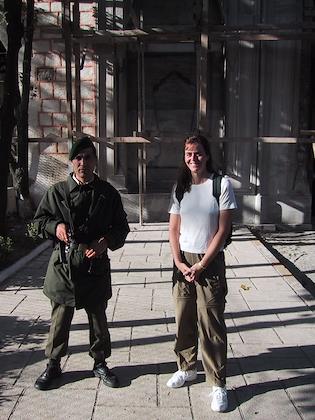 | 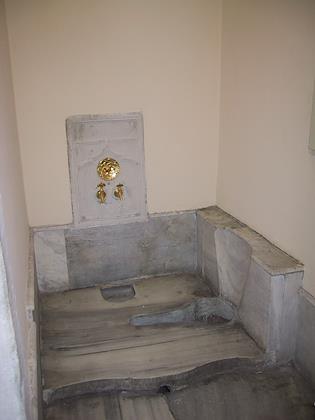 | |
| Just outside the Topkapi palace in Istanbul, which was the living quarters of the sultans from the 1400 until the early 1800. Many of the tourist facilities are heavily guarded, because the Turks want to protect the tourism industry from potential terrorist attacks. This guy was a lot friendlier than he looks. | This is a Turkish style squat toilet in the palace, with facilities for hand washing. Only the best marble for the Sultan, of course. | |
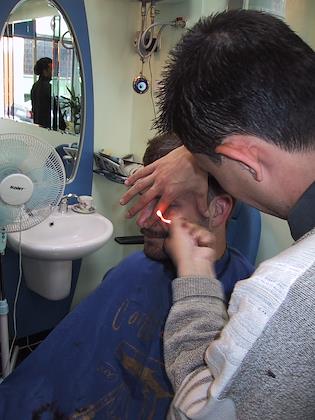 | 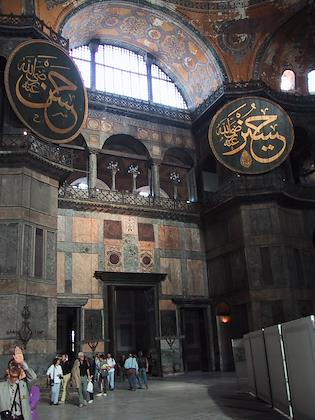 | |
| Eric gets a haircut. Part of the procedure is to burn off hair on the face and the ears. Pretty scary! | This is the inside of the Aya Sofia in Istanbul, which was first a church, then a mosque, and now a museum. Notice the huge Islamic placards hung up to make it less church-like. The placards display the names, in Arabic, of God, Mohamed and the 4 caliphs. | |
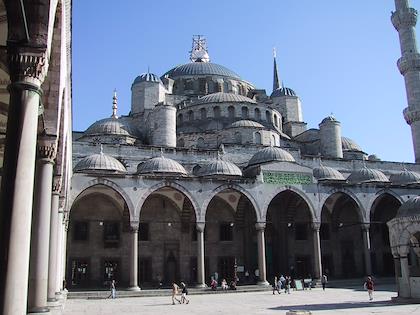 | 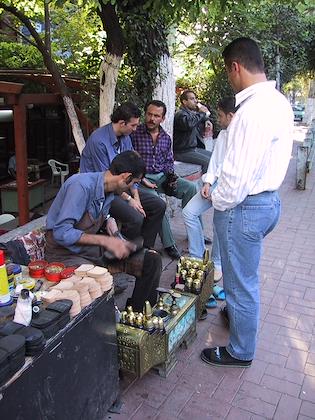 | |
| The courtyard inside the Blue Mosque in Istanbul. | The shoe-shiners often had a very elaborate setup, with burnished brass jars of shoe polish. | |
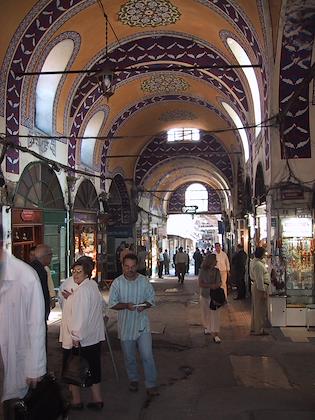 | 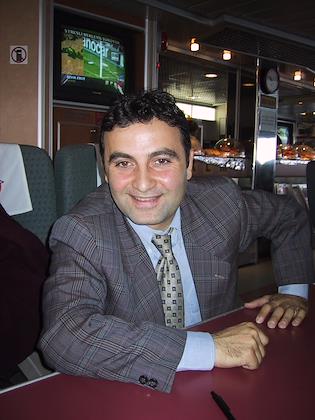 | |
| This is at the famous covered market, or Grand Bazaar. Most of the shops appear to cater to tourists, so of course there's dozens of places to buy a carpet. | We took the ferry from Istanbul to Bursa. On the ferry we met Zeki, a salesman for a clothing dye company. He goes to Bursa every week to sell dye to the towel factories out there. Zeki is a very generous and charismatic man. He'd been to America for about a year, and really loved it there. He spent the whole day driving us around, showing us the area, and bought us lunch and dinner. | |
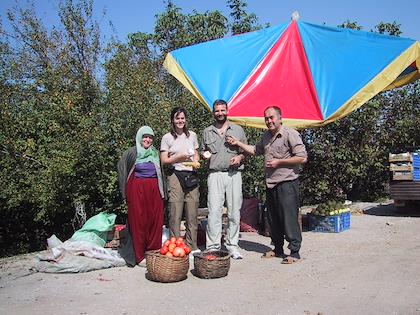 | 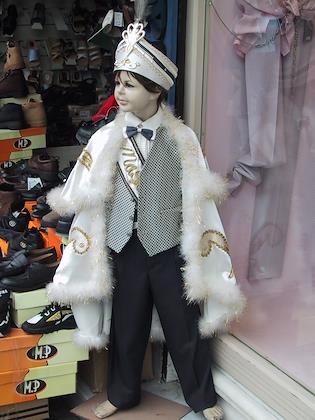 | |
| Zeki drove us up Uludag, a mountain that rises up behind Bursa. Along the road was a farmer selling his products--quinces, apples, and walnuts. He presented us with a large bag filled with everything he sold, as a present. It was the first time we'd tasted quinces--they're tasty, similar to apples, but very hard and a little more acidic. | 20 guesses as to what this is for. Can't guess? Well, around the age of 8 or 9, boys are circumcised in Turkey. There's a big ceremony and party, and the boy gets to wear this special suit. (Oh boy, that sure makes up for it!) | |
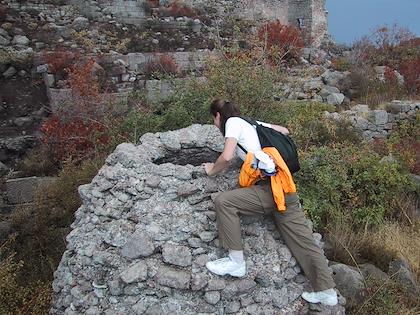 | 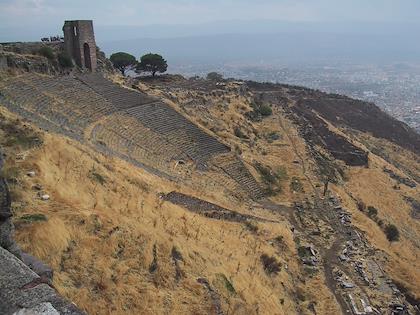 | |
| In the ruins of ancient Pergamum, these kilns were everywhere. We wondered what they were, and later discovered that in the middle ages, people took marble from ruins, and burned it in these furnaces. The resulting material (lime, I believe) was used to make the whitewash. | This is the theater at Pergamum. I was very impressed--it was our first theater. Normally they're wider and not as high, but this one was built up. | |
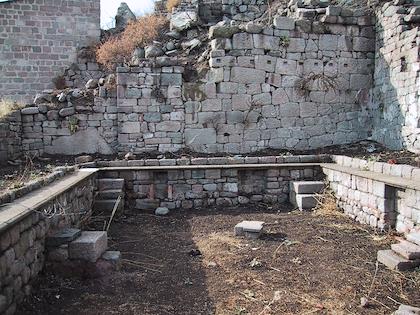 | 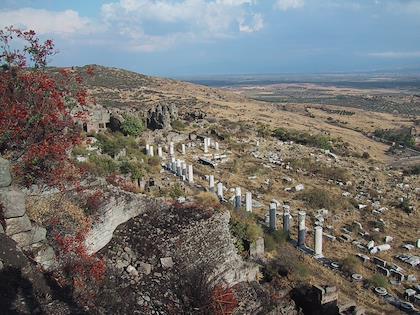 | |
| We didn't know what this was at the time we saw it. After seeing many more ruined cities, it was obvious to us--it's a bath! People walk down the steps into the bath. | This was the gymnasium in the middle city of Pergamum. | |
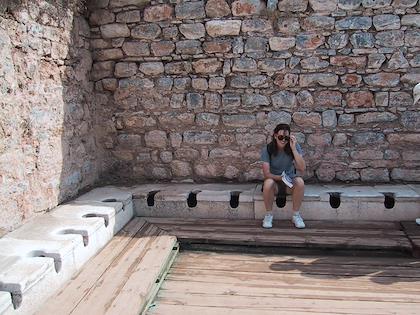 | 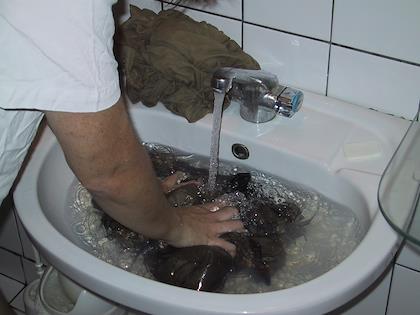 | |
| The public toilets in Ephesus. Very cozy and intimate. | In coastal Kusadasi, the first hotel we stayed at had no hot water. The next morning we changed hotels, and took a shower. We also washed clothes, which we'd been doing in hotel sinks the whole time. After this, we always tested hotel rooms for hot water before checking in! | |
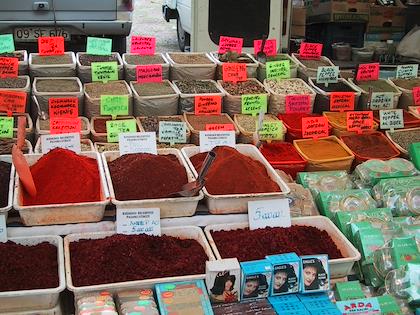 | 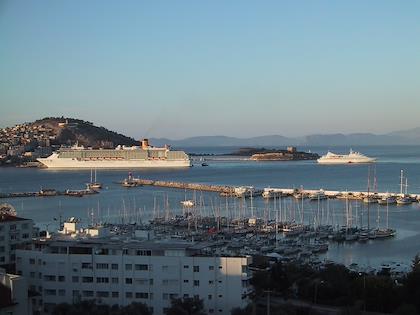 | |
| Spices for sale. Oddly enough, although we saw spices for sale everywhere, most Turkish food we had didn't seem very spicy at all. | Sunrise from the hotel in Kusadasi. You can see one small and one huge cruise ship coming in, with Pigeon Island between them. | |
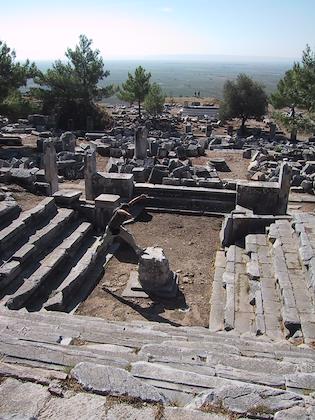 | 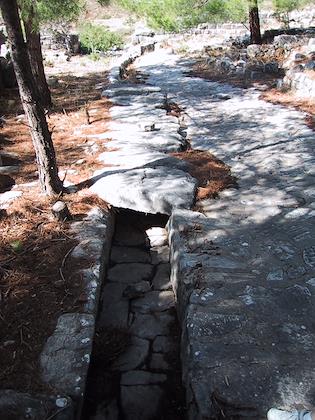 | |
| In the ancient city of Priene, this was the Council Chamber (something like City Hall). As you can see, it was in superb condition. Notice Eric leaping to the speakers column. | An ancient road in Priene, with a covered gutter running down the side. | |
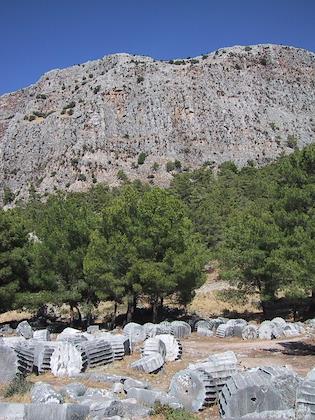 | 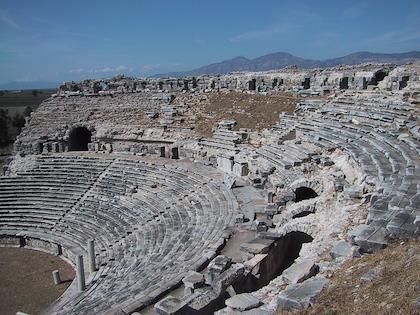 | |
| Mt Mykale, with pieces of crumbled columns in the middle. We started a game here--to get from place to place, you had to step on pieces of ruins. We called the broken up fluted columns "gears". They look a lot like gears, don't they? | The theater at Miletus. Notice the upper and lower walkways, some partially collapsed. | |
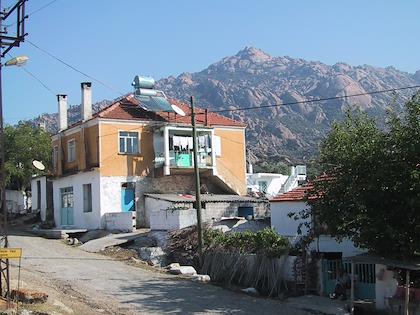 | 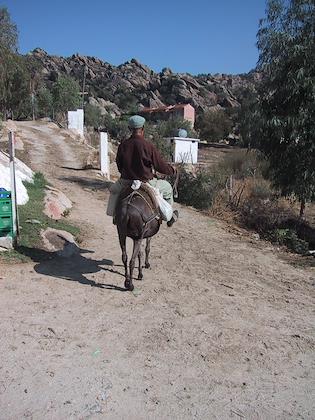 | |
| In the small village of Kapikiri. The mountain that towers over the village is Besparmak Mt., or Five Fingered Mountain. Notice the solar water heater on the house. They're very common here--I think most water heating in costal Turkey is solar. | Donkeys were everywhere in this village. Maybe this was the one that brayed loudly all throughout the night, and kept us up! | |
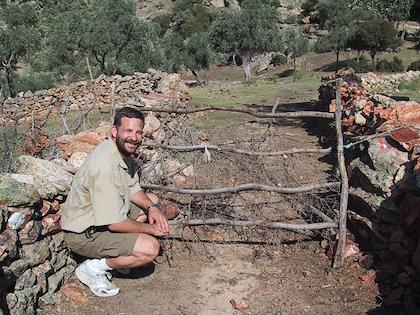 | 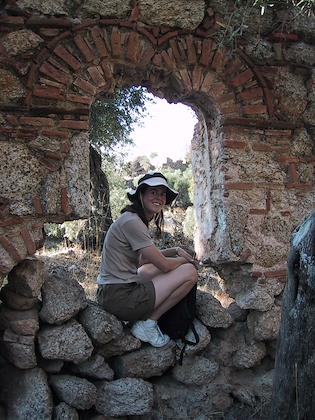 | |
| We took a hike up to the ruins of a Byzantine monastery near Kapikiri. Fences along the path were always homemade affairs, made of brush, branches, and twisted wires.. | There were unusual double-arch windows and doorways at the monastery. | |
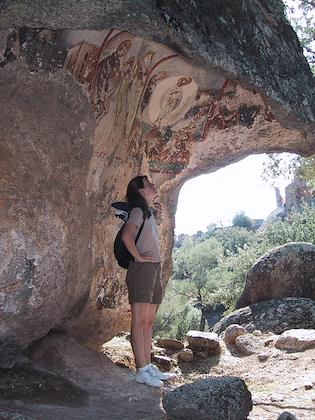 | 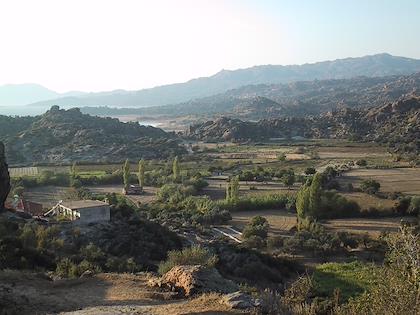 | |
| This fresco, painted under a rock, would have been impossible to find had we not met an older German couple coming down when we were going up who gave us directions. The overhang of the rock was plastered, and the fresco was applied to the plaster. | More great views of the lake area from the monastery area. | |
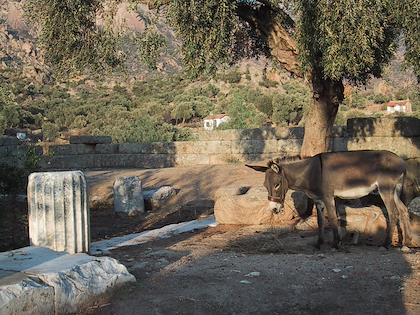 | 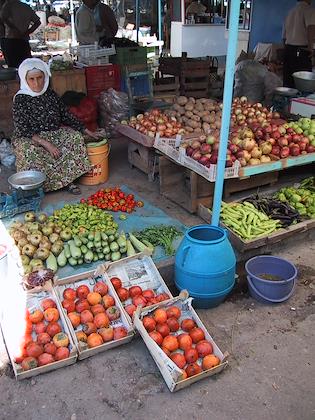 | |
| Cows and donkeys are kept right in the middle of ancient ruins. | A typical market in Turkey. We bought our usual, tomatoes, cucumbers, and apples here. I wish I could pay Turkish prices for fruits and vegetables in the US! This woman is selling persimmons, which I haven't seen in Turkey before. | |
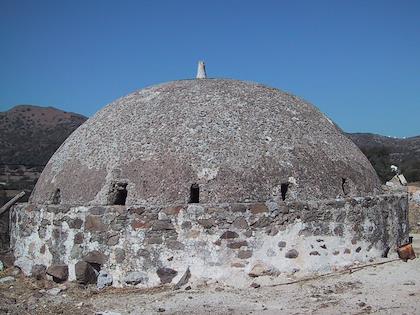 | 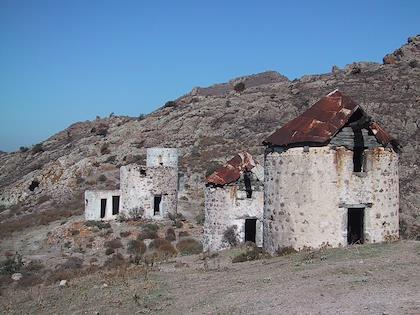 | |
| We drove around the Bodrum Peninsula, stopping here and there to take some pictures. These cisterns were everywhere, even though they're not in use anymore. | These windmills were set up on high passes, where there was a constant wind. I assume they were for milling grains. | |
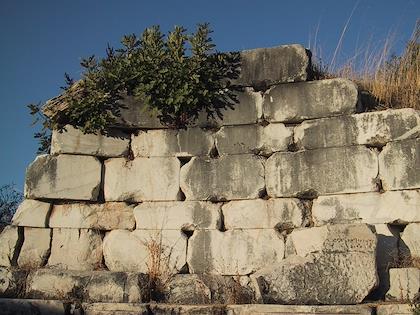 |  | |
| This is in the ancient city of Stratonikea. You can see here the holes where people dug out the metal connecting the blocks together. | In Fethiye, we sat at the same table as Pat and Charles Newman for dinner, and ended up talking with them for about an hour. They were a very charming and friendly English couple that has come to Turkey about 10 times over the past 10 years, and have seen many changes. They seemed to have made friends all over town--about 3 groups of people stopped by and said hello to them while we were eating. | |
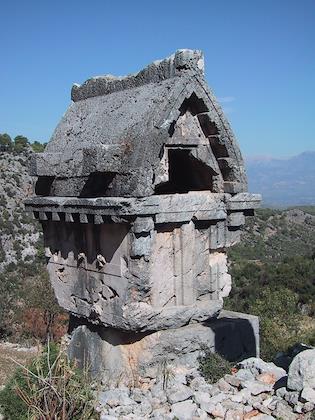 | 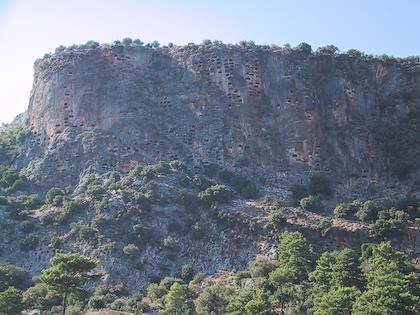 | |
| In the ancient city of Pinara, we found a sarcophagus that's remained relatively intact. | Here you get a better idea of what the mountain behind Pinara looked like--it was riddled with tombs. It would have been fun to spend a couple days here, and hike to a few of these old tombs. | |
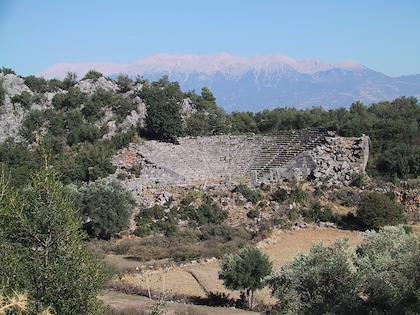 | 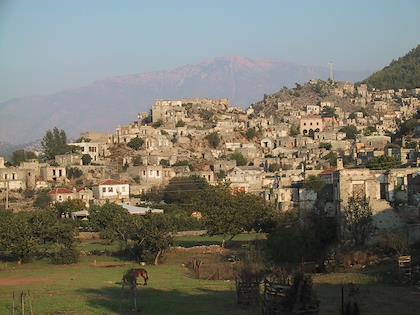 | |
| From higher up in the city we had great views of the theater and surrounding mountains (the Taurus range). | Later on in the day we went to the abandoned village of Kayakoy. Apparently in 1922, there was an exchange of population between Greece and Turkey--the ethnic Turks in Greece were to go to Turkey, and the ethnic Greeks in Turkey were to go to Greece. This village used to be a Greek village, but after the Greeks left, it was never resettled. It's an eerie place to walk around. The buildings have all been stripped of anything useful, and many of them look like they've been destroyed on purpose. None of them have roofs. | |
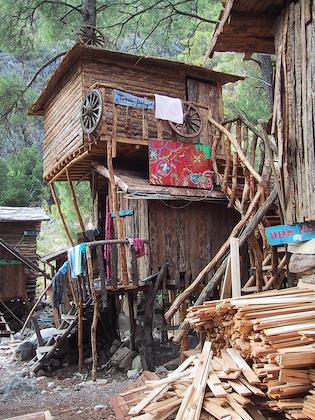 | 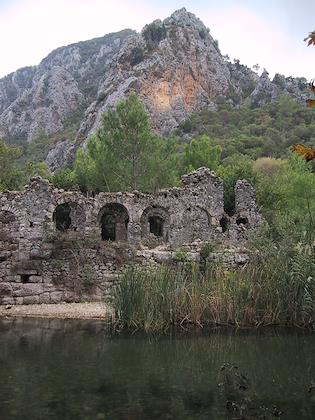 | |
| One of our planned stops along the way to Kemer was Olimpos, a very fine and scenic set of ruins. This is an unplanned stop--it's a treehouse hotel/hostel, catering to young travelers planning on staying there for a while. There were some very funky buildings. | A stream runs through the site to the ocean. Very senic. | |
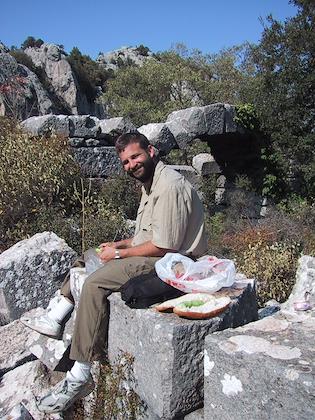 | 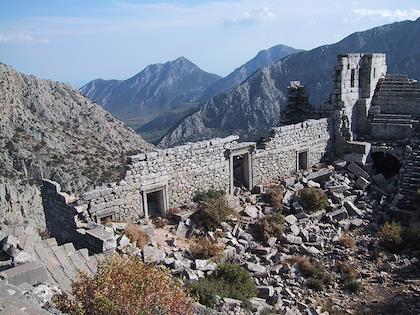 | |
| Eric, making lunch in Termessos. | The theater in Termessos. This theater was stunning, and by far my favorite among all that we've seen. | |
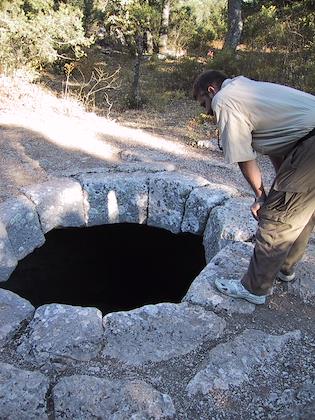 | 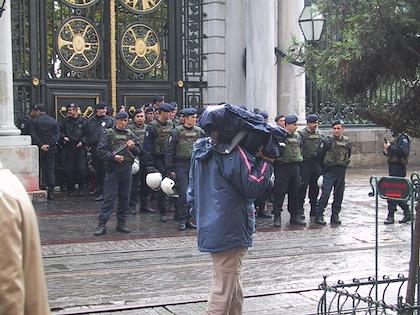 | |
| One of the most interesting parts of Termessos was the water system, including cisterns. There were huge tanks built into the ground. They probably could have withstood a long siege. | Back in Istanbul, we were walking on Istiklal Caddesi, a major pedestrian street, when we ran into this demonstration. We got conflicting reports from people we asked questions of on the scene, but here's a report from Amnesty International about it: http://www.web.amnesty.org/ai.nsf/index/EUR440171998. There were lots of armored police around. | |
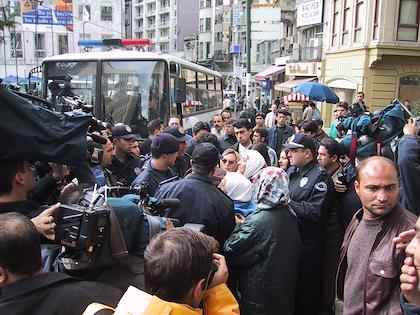 | 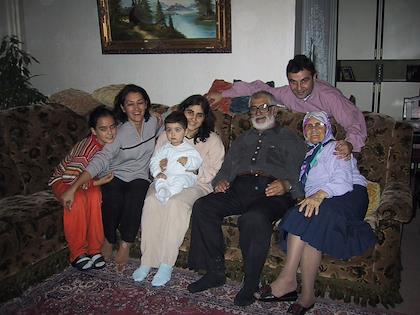 | |
| Zeki, whom we met on the ferry to Bursa, invited us to dinner. This is the whole family, including Zeki's sister-in-law and her daughter. | ||
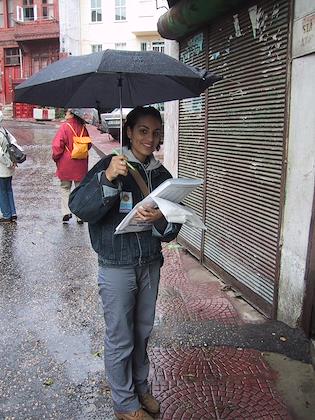 | 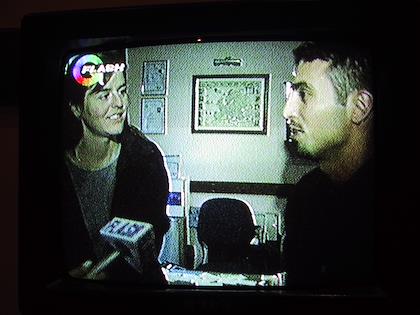 | |
| The day before we left was a nationwide census. Everyone except tourists had to stay inside all day to be counted--no kidding! We saw this census taker going from door to door. Some of the questions they asked were: how many bathrooms are in this house, how many children do you have, are you working, can you read, what is your occupation. | We got onto Turkish television! Some reporters wanted to interview tourists and see what they thought of the census, so they went to our hotel and happened to find us. This is a photo of the TV show, which we watched that night. | |